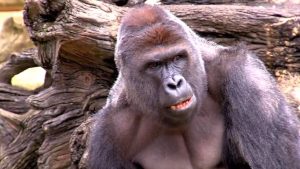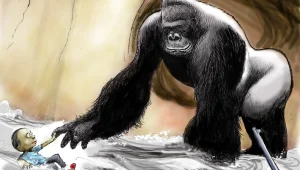Harambe’s Death: When and Why Was the Gorilla Killed?
Harambe, a 17-year-old western lowland gorilla, was unfortunately killed on May 28, 2016, at the Cincinnati Zoo in Ohio. The incident unfolded when a three-year-old boy fell into the gorilla’s enclosure, sparking a tense and highly precarious situation. In response to the potential danger posed to the child by the 450-pound primate, zoo officials made the difficult decision to shoot and kill Harambe. This action was taken out of a perceived necessity to protect the child’s life, as tranquilizers were ruled out due to their delayed effect which could have aggravated the gorilla and further endangered the child’s life.
The event sparked massive global attention and controversy, with many questioning the zoo’s decision to kill Harambe and others expressing concern over the safety measures in place at zoos. The incident highlighted the critical need for more stringent safety protocols in zoos and ignited a broader conversation about the moral implications of keeping animals in captivity for our amusement. Despite the tragic end, Harambe’s death has left an indelible mark on the world, forcing us to reevaluate our relationship with these magnificent creatures, and how we can better coexist in a way that respects their right to life, freedom, and safety.

What Happened to the Child Involved in the Harambe Incident?
In the year 2016, an incident occurred at the Cincinnati Zoo that captured global attention. A three-year-old boy fell into the gorilla enclosure, leading to the tragic shooting of the 17-year-old Western Lowland gorilla, Harambe, by zoo officials, fearing for the child’s safety. The boy who was involved in the incident was reported to have sustained injuries but survived the ordeal. According to updates provided by his family, the child recovered fully from the physical injuries. He is reportedly leading a normal life, with his identity being kept out of the public eye as much as possible to protect his privacy and allow him to grow up away from the glare of media scrutiny.
This was a crucial step taken by the family to prevent any potential psychological effects from the incident. The event sparked global debate about zoo safety and the treatment of animals in captivity, leading to changes in policies and practices in zoos worldwide to ensure the safety of both animals and visitors. The incident also resulted in increased awareness about the endangered status of Western Lowland gorillas and the need for their conservation. Despite the tragedy, the boy’s survival and recovery, along with the positive changes in wildlife conservation and zoo safety, have been some silver linings in an otherwise heartbreaking incident.
Timeline of Harambe’s Death: Key Events
Harambe, a 17-year-old Western lowland gorilla, lived in the Cincinnati Zoo until his untimely death on May 28, 2016, which stirred a global controversy and sparked heated debates. On that fateful day, a three-year-old boy managed to slip into the gorilla’s enclosure, a dangerous situation that prompted the zoo’s Dangerous Animal Response Team to intervene. Understanding the potential threat to the child’s life, they chose to shoot Harambe, resulting in the gorilla’s death. This decision was met with a massive public outcry as people from around the world questioned if the zoo had exhausted all other safer options before resorting to lethal force.
In the wake of Harambe’s death, numerous protests and vigils were held, both at the zoo and online, with people expressing their grief and anger. The incident sparked a widespread debate on animal rights, zoo safety protocols, and parental responsibility. Moreover, it led to an explosion of memes and tributes on social media, which turned Harambe into a symbolic figure of animal rights.
Despite the controversy, the Cincinnati Zoo stood by their decision, citing the unpredictable nature of a wild animal and the immediate danger the child was in. The zoo’s response did not quell the public’s anger, but it did draw attention to the need for stricter safety measures in zoos.
In the aftermath of this unfortunate event, Harambe’s name became synonymous with the call for better safety protocols in zoos and a more humane approach towards dealing with animals in captivity. His death, while tragic, has served as a powerful reminder of the need to balance human safety with animal welfare and has had a profound impact on the discourse surrounding animal rights and the conditions of animals in captivity.

The Circumstances Leading to Harambe’s Killing
The incident that led to the tragic demise of Harambe, a 17-year-old Western lowland gorilla, was a series of unfortunate events that unfolded at Cincinnati Zoo on May 28, 2016. A three-year-old boy managed to slip into the gorilla’s enclosure, which triggered an emergency response from the zoo’s Dangerous Animal Response Team. The boy’s entrance into the habitat created a potentially dangerous situation as Harambe, weighing in at more than 400 pounds, was an incredibly powerful creature.
To the spectators, Harambe’s behavior seemed unpredictable as he alternated between seemingly protective gestures and abrupt, possibly aggressive movements. The video footage showing Harambe dragging the boy through the water of the moat further escalated the tension and concern for the child’s safety. Despite the observation from some animal behavior experts that Harambe did not appear to be behaving aggressively towards the boy, the zoo’s response team made the decision to shoot Harambe, citing the child’s immediate danger.
The decision was made under immense pressure, as tranquilizing Harambe was ruled out due to the time it would take for the drugs to take effect as well as the potential agitation the dart might cause. Thus, the unfortunate decision to kill Harambe was taken to ensure the safety of the child. This incident sparked a global debate on the ethical considerations of keeping wild animals in captivity, the responsibility of zoos for the safety of both their animals and visitors, and the need for enhanced preventative measures to avoid such tragic outcomes in the future. Ultimately, Harambe’s death underscores the complex interplay between human-animal interaction in a confined setting and highlights the imperative need for enhanced safety and conservation measures for these majestic creatures.
Public Reaction and Controversy Surrounding the Incident
The incident in question has sparked a maelstrom of public reaction, igniting an intense debate that has transcended social boundaries and permeated various platforms. The controversy surrounding the incident has elicited a myriad of perspectives, demonstrating how complex and multi-faceted public sentiment can be. Some individuals have passionately defended the actions taken during the incident, arguing that the measures employed were necessary considering the circumstances. They view the incident as a manifestation of societal realities that need to be addressed rather than condemned. This group often emphasizes the importance of contextual understanding and the necessity of difficult decisions in trying times.
Conversely, a significant portion of the public has expressed vehement disapproval, viewing the incident as an overt transgression of ethical norms and basic decency. They argue that the incident represents a dangerous precedent that threatens to undermine societal stability and harmony. They often highlight the repercussions of the incident, drawing attention to the potential harm it may inflict on vulnerable segments of the population. As such, they advocate for accountability, transparency, and a thorough investigation into the incident.

The controversy has also had a polarizing effect on the public, driving a wedge between different sections of society. It has triggered widespread discussions and debates, becoming the focal point of both mainstream and social media. The profound public reaction to the incident underscores the societal relevance and importance of the issue at hand.
Despite the spectrum of views, one thing is clear: the incident has struck a nerve within society, underscoring the need for open dialogue and understanding. Whether one agrees or disagrees with the actions taken, it is undeniable that the incident has given rise to a critical conversation about societal values, expectations, and the complexities of decision-making in a world often riddled with grey areas.
Aftermath and Legacy: What Happened Following Harambe’s Death
In the wake of Harambe’s tragic demise in May 2016, a multitude of ripple effects were felt across the globe. Public outcry was immediate and international, spanning social media platforms and triggering widespread debate about animal rights and zoo security measures. This tragic incident sparked a resurgence in activism, ultimately leading to increased awareness and advocacy for the safety and well-being of captive animals. The Cincinnati Zoo, where Harambe lived, faced intense scrutiny and became the subject of numerous investigations regarding its safety protocols. The incident also brought to light the plight of Harambe’s species, the Western Lowland Gorilla, a critically endangered species, and prompted renewed efforts in conservation.
The influence of Harambe’s untimely demise extended to other sectors as well. The incident became a cultural phenomenon, with Harambe becoming a symbol for various causes and movements. Tributes and memorials proliferated, ranging from heartfelt condolences to satirical memes. The story of Harambe was turned into books, songs, and even a video game, showcasing the broad reach and enduring impact of this event.
Harambe’s death also had an unexpected impact on the way people interact with and perceive zoos. The incident served as a stark reminder of the inherent risks associated with keeping wild animals in captivity and led many to question the ethics of zoos. Many animal welfare groups used this incident to highlight the need for more natural living conditions for animals in captivity and to advocate for greater protection for endangered species.
In conclusion, Harambe’s death had far-reaching effects that transcended the confines of the Cincinnati Zoo. It sparked global conversations about animal rights, zoo safety, and species conservation, and its cultural impact continues to be felt years later. Despite the tragedy of his loss, the aftermath of Harambe’s death has served as a catalyst for positive change in animal welfare and conservation efforts.
